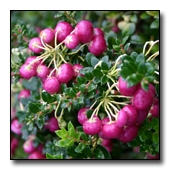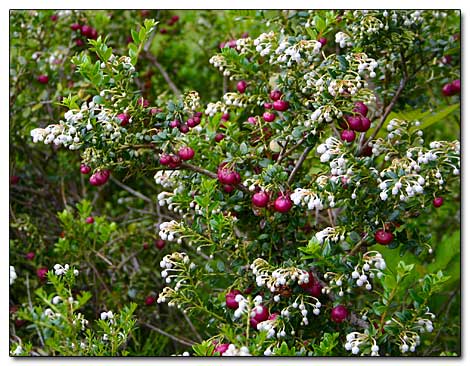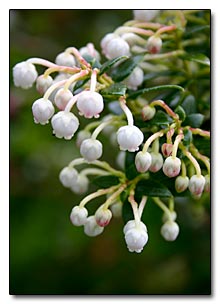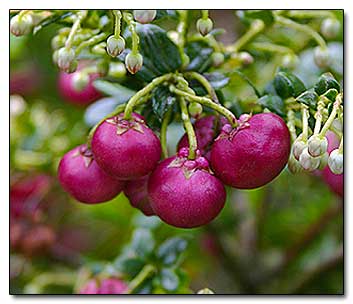Gaultheria mucronata
PRICKLY HEATH
syn. Pernettya mucronata
Family: Ericaceae
Pronounced: gal-THEE-ri-ah moo-kro-NAY-tah

Quick Jumps
Growing Guide
Rainy Side Notes
GROWING GUIDE

Geographic Origin:
Argentina, Chile.
Plant Group:
Evergreen shrub.
Hardiness:
Sunset zones: 4-7, 15-17.
USDA zones: 7-9.
Mature size:
Height: 4 feet (1 m).
Width: 4 feet (1 m).
Flowering period:
Late spring and again in fall.
Flowering attributes:
Tiny, white, urn-shaped flowers followed by magenta berries.
Leaf attributes:
Small, prickly, dark green, evergreen leaves, turning bronze in fall.
Growth habit:
Spreads by underground runners.
Light:
Full sun to partial shade.
Soil:
Moist, acidic, peaty soil.
Propagation Methods:
Sow seed in Autumn, winter over in cold frame. | Semi-ripe cuttings in summer. | Dig up rooted suckers in spring.
Pruning Methods:
Prune tops for shape. Remove suckers to keep in bounds.
Pests and Diseases:
Powdery mildew, black mildew, leaf gall and fungal spots may be a problem.
Rainy Side Notes


Four years this evergreen shrub has been growing in my Pacific Northwest garden and remains disease and pest free. I under planted the shrubs with a shorter male clone, Gaultheria mucronata 'Thymifolia', for pollination. G. mucronata produces a lot of pinkish-mauve to wine colored berries that persist on the shrubs through fall and winter. As you can see in the photo above, the berries are there in May too.
This suckering shrub can take root pruning of the suckers with a shovel to keep it in bounds, although it has not proved to be a thug. It makes an exceptional informal evergreen hedge.
In 1825, French botanist Charles Gaudichaud-Beaupe named the shrub pernettya to honor Antoine J. Pernetty. In 1990, it was determined that gaultheria and pernettya should not be a separate genus. Pernettya merged and is now called Gaultheria. However, some in the nursery trade still sell it under the old name.
Photographed in author's garden.
A Pacific Northwest Plant of the Week (2011)
Debbie Teashon
Photographed in author's garden.

Gardening for the Homebrewer: Grow and Process Plants for Making Beer, Wine, Gruit, Cider, Perry, and More
By co-authors Debbie Teashon (Rainy Side Gardeners) and Wendy Tweton

